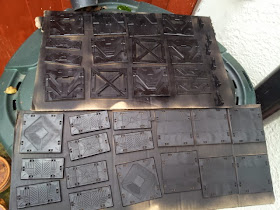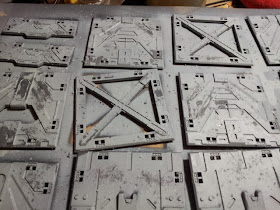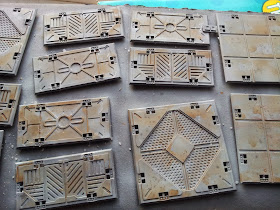I went in fairly heavily for the Deadzone terrain. I pledged for enough mats for a complete 6x4 table, so I wanted enough building tiles, at least when combined with my existing stock of GW stuff, to cover them. Of course, now I have to paint them all...
I want to paint them quickly so I don't just end up with a bunch of unpainted sprues and parts. But I also want them to look good. Partly out of personal pride in my work, of course, but also because I want people to see that this is quality terrain - that Mantic have made a good product. So here's my guide to getting my tiles looking good quickly, as well as some optional 'effects' stuff you can do on top of the paint job to really get it looking cool.
To start with, I sorted my tiles into two piles: one for wall pieces, barricades, and vertical connectors, the other for floor tiles. I am not going to be painting the right angle connectors here. That's partly because most of them will be invisible once the tiles are clipped together, and partly because the ones you can see won't be coloured that differently to the tiles anyway. This is a speed run. But if you want to spend hours painting all the clips, go for it ;)
Next, I blu-tacked the tiles onto sheets of cardboard. Note I only have a dozen or so tiles on each sheet. This is because this was the test run to check the colours ad techniques all worked and looked good. But you save more time the more tiles you stick up each time, so I'll be doing twice as many tiles at a time in future.
Its important to keep the vertical sections all aligned the same way. So the top of every wall is at the top of the card sheet, the bottom of every wall is at the sheet's bottom. It doesn't matter which way you line up the floor tiles.
Once the sheet is full, I took them out to the garden and primed them black. Most of the time I tell people it really doesn't matter what colour primer you use. But here, its important to use black. Any black - GW, Army Painter (which I use), or Halfords. But Black.
 |
| Check those corners |
When the primer is dry, I sprayed the tiles with Humbrol Acrylic Sea Grey. This is a dark grey, almost black.
 |
| A slightly uneven paint job will give your tiles 'character' |
A smooth finish is not vital here - you can afford to be a little patchy. This may be counter-intuitive. You're always told that you need to get smooth layers of paint on models. But this is large scale terrain and a little variation in tone and texture is normal and natural and will make your tiles look better and more realistic when you're all done. I'm not saying leave parts of the tiles blank or to skimp on the paint. Just that you don't need to plaster the plastic trying to make every square millimeter of the thing a flat matte uniform shade.
I also spray the paint down onto the tiles. I don't mean just holding the can above the tiles, but firing it from the direction that is at the 'top' of each tile. This is most easily done by holding the sheet of card with my hand at the top of the sheet, and then spraying away. What this does is put a bit less paint on the bottom of any raised surfaces on the tiles. Doing it this way you get a 'drop-shadow' effect. It means you have shaded the tile without even trying and this is why you needed to make sure all the tiles were lined up the same way and primed with black paint. Again, this effect will be helped by not blasting every tile with paint until it squeals for air.
Note: this effect is probably easier to achieve with an airbrush than a spray can. But speed is more important right now.
So now we have a sheet or sheets of tiles, all primed, and all base-coated. Now its time to apply the main colour.
At this point I switch to the airbrush.
I would guess that at least one person reading this now is thinking 'airbrushes are expensive' or 'airbrushes are for expert painters' or something like that. Let me assure you, neither of those statements are correct.
My airbrush is really basic. It was a cheapo ebay purchase - £75, I think, for two (!) brushes and a compressor. For that I got a half-decent compressor and two basic airbrushes. It literally pumps air through the brushes and forces paint to go along too and thats it. No fancy gizmos, no variable apertures or trigger resistances. It is one step up from what I would recommend anyone unable to get what I did - a GW spraygun. I think these are around £15 now and you'll need a can of compressed air too. Either of these systems will do for this, giving you the ability to spray much finer layers than a can and much smoother, more even layers than a brush.
Now its time to talk about the coolest part of the process - salt masking. Salt masking is using chunks of salt to mask areas of your model so they don't get any paint on them in the next layer. Its a fantastic technique to simulate wear and tear on painted surfaces. There are other ways to do it but salt-masking is the coolest. It looks like cookery but feels like magic when you do it right.
You will need:
- salt, proper rocky or crystallised salt, the sort that goes in a grinder, not table salt. I use Waitrose Coarse Sea Salt Crystals.
- hairspray. Get the cheapest stuff you can find. I use Tesco Value.
 | |
| Ready salted. |
When it is, load up your airbrush or spray gun with the main colour for the tile. I used Vallejo Model Air Pale Grey Blue as it seemed like a nice match to the Deadzone mats.
In theory Model Air paints don't need any diluting. In practice I found the Grey to be a little thick, so I did cut it with a tiny bit of Tamiya Thinners. You want a fairly even coat here, but as with the previous step, a little patchiness is quite acceptable. Take note, some of the salt will probably fall off here, so make sure you're painting on a surface you can collect it from easily afterwards. As with the base coat, spray the wall tiles from their top side to accentuate that drop shadow effect.
Once this layer has dried, you will need a pot of warm or hot water and some cotton wool. Dip the wool in the water and use it to wipe off the salt crystals from the tiles. Now check out that magic! Say to yourself, 'Boy, can I paint!'. It doesn't matter if you scratch the paint as you go, or find slightly thicker areas where the light grey paint peels or rubs off. The more damage you do to it the better really.
 |
| Boy, can I take photo's. |
But all that grey can be a bit overpowering though and make a table look a bit washed out. Don't get me wrong - a collection of salt masked tiles put together will make some impressive looking scenery people will love playing on. But for a little extra 'pop' I added some accent colour and used the salt mask technique again.
For my first batch of tiles I chose Vallejo's Game Colour Gold Yellow. At first glance this seems like a really strong colour. But you have to bear in mind the cold/hot colour model. That is, if you use lots of 'cold' colours - greys, some blues, some greens, - you can accent it with a contrasting 'hot' colour. In this case I have cold greys everywhere, so I am contrasting it with the warm yellow. Reds would also work, and probably some browns and purples as these also have red pigments in them.
I used Tamiya's masking tape to protect most of the tiles, then salt-masked the tiles as above before airbrushing on the yellow. Here's how they look when I wash off the salt.
You don't need to do this accent step to every single tile. I did it to every one of the first batch just so I wouldn't need to do it again. If you did do it to every tile, well, you'd lose a bit of that individuality and leave your table looking all uniform again. I'll probably do a few more of the barricade tiles, just because it seems to make narrative sense these things would be painted to stand out a bit. But not every single wall and every single door needs to be marked out the same.
Note I only did this on the vertical tiles too. For the floors I did a quick wash with GW's Steel Legion Drab and dabbed it all over the tiles. Steel Legion is great for a generic 'dusty' look and here's how the dried tiles look.
Its probably a good idea to give the tiles a coat of varnish at this point and I used Army Painter's Matt Varnish. These things are going to get a lot of wear and tear as they get put together, played on, and taken apart again.
The next step should be obvious: take the tiles off the board, turn them round, and do it all again to the other side. I might not even bother doing the floor tiles again though. One side is all you're ever likely to really see and that's done.
Take care when spraying paint on this second side though. Don't forget you have already painted the first side and you don't want paint creeping under the tile and ruining your paint job. A little stray paint won't hurt, just don't spray the tiles from extreme angles.
The most time consuming part of this whole process then is tacking the tiles onto the cardboard. Spraying the first two coats takes maybe five minutes. Spraying on hairspray and sprinkling on salt takes a bit longer, particularly as you have to wait for the hairspray to dry. Masking up areas for the accent colours is a little time consuming. But if you do a big enough sheet of tiles you only need to do it once. Get big tape. All in all, it is quite possible to paint scores of tiles, on at least one side, in an afternoon.
edit:for those put off by airbrushing or salt masking go here for a guide to similar technique that uses neither.
Hopefully then, this guide has been useful to someone and I'm always open to questions or ideas for other ways to do things so feel free to leave a comment and, if you liked the guide, please click on the ad at the top right :) And check out my guide to weathering your tiles here.



Fantastic!
ReplyDeleteI plan to try something similar to this, but I intend to permanently assemble some (all?) of the buildings first. In your opinion how would that affect the process shown?
Thanks for the tutorial :)
I reckon it would make painting the 'insides' of the buildings harder as you would have the roofs getting in the way of the spray. What you could try is gluing the wall and ceiling sections together first, butnot any right angle joins, paint them, then glue the walls to the ceilings and floors. That way you would be painting the connectors at the same time too.
ReplyDeleteI'm putting up a post on my blog directing people here. Do you mind if I use an image from your two articles on my blog?
ReplyDeletehttp://tyler.provick.ca
Thanks,
Thanks for this guide. I tried it all using Halfords Primer Grey and a lighter Tamiya grey primer instead of an airbrush. I also found a mix of Saxo course salt and normal table salt got the best distressed effect. Thanks again!
ReplyDeleteGreat tutorial! A question: the hairspray doesn't affect the adhesive quality of the next layer of paint? Im talking about the colour you want to stick, not what you'll be washing off with the salt.
ReplyDelete@reptorama that sounds good. I think I mentioned seeing someone do it with table salt and it gave a slightly different effect, I think I might try that mix on my next batch too.
ReplyDelete@scott not at all.
ReplyDeleteThanks
Deletewhat would u recommend when the salt treatment has gone a bit out of stray? I used some salt which was very coarse and sprinkled prolly to much and now it looks more like urban camo then weathering. Do u think respraying is the best option?
ReplyDeleteI've done a few where quite a bit of the paint has come off too. It's not necessarily a bad thing though - its ok for one or two panels to look really beaten. Don't forget, the backstory for these things is they are essentially freight containers that have been used to ship goods to a planet, then been broken down and reassembled as living quarters and such. So a fair amount of wear and tear is to be expected and some panels are going to get more knocked about than others. But really its up to you. Have you put some buildings together to see how they look? If they look cool, leave 'em :) If you want to try it again but hold the salt a little, why not? I'm going to put up another guide in the next day or two to extra weathering as well, adding mud and dust to panels that might also help blend them together a bit more.
ReplyDeletewell i might see what they look like assembled, but from what i have seen atm they will look to busy for the eyes, if u know what i mean. The weathering has lost his subtlety .. thnx for the quick reply!
ReplyDeleteI used the salt masking on my tiles, worked fantastic - then I bought the ruined tiles sets to add a bit of variety.
ReplyDeleteNow what would your opinion be there? 2 things there is an "under layer" visible in areas and metal rods as well.
I used spray platemail for beneath the outer layer of paint, so I was thinking the rods need to be a different metal - but what would you suggest for the underlayer?
Here's a link to pics of my terrain
http://gwpertinent.blogspot.com/2014/02/first-deadzone-terrain-piece-finished.html
Hi,
ReplyDeleteActualy i just want to know that, Which paint sprayers better for me?
With which I can paint my house, furniture and other myself?
It would be great for me if you could tell me a little bit Please?
And How long will it last? please reply me soon. Air Compressor for Spray Painting
This looks good! I've included a link to your work in our article: Battlezones miniature scenery system for Deadzone from Mantic Games
ReplyDelete